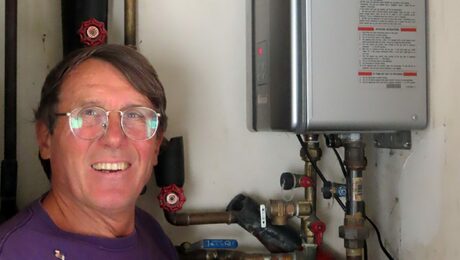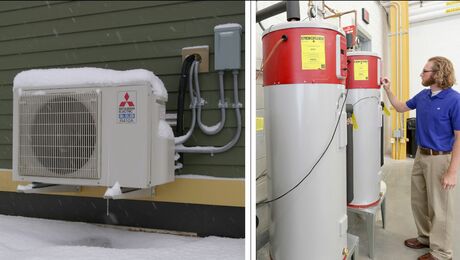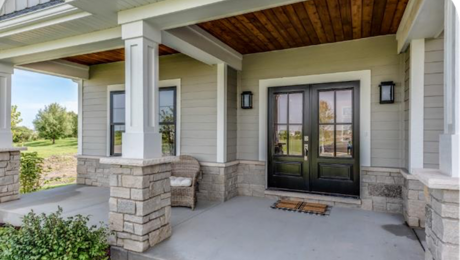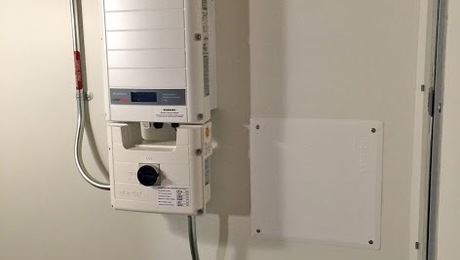Zone 6 R-Sheathing
Hello!
I am currently constructing a home in North Dakota (Zone 6). We used Zip R6-Sheathing (R 6.6) and plan to used fiberglass bats in the 2×6 walls (not yet installed). The front wall is actually 2×8 due to some big windows.
Our intent was to create a tight, energy efficient home, and to deaden sound; however, now that we have the sheathing on and are siding, I have read people stating that R-sheathing is not well suited for cold climates and that we should have used a thicker foam and placed it on the exterior side of the sheathing.
So my question is this: What should we do, at this point, to ensure our walls do not have moisture issues or that they dry appropriately when moisture does enter the wall? For what it is worth, the siding is LP Smartside.
Thanks in advance!
Jeff
GBA Detail Library
A collection of one thousand construction details organized by climate and house part









Replies
Jeff, Zip-R can work fine in zone 6, but it needs to be their R-12 product, and the cavity insulation should not exceed R-21. You can add closed cell spray foam to the interior to create a flash-and-batt detail, just make sure at least 35% of the R-value is on the exterior. A riskier solution that could work (no guarantees) is to install a variable permeance membrane on the interior, such as Siga Majrex or Pro Clima Intello, and to keep a close eye on your interior humidity levels.
Michael, Thanks for the reply. The r-6 product has already been installed, however, the wall cavity has not been insulated. So I am attempting to determine how I can ensure my walls function properly using the R-6 product. Thanks!
Jeff, I understood that--although I try to avoid spray foam, this is a good situation for it. Just spray an inch or two of closed cell foam on the interior of your sheathing, and fill the rest of the cavity with fluffy insulation. For more info: https://www.greenbuildingadvisor.com/article/flash-and-batt-insulation.
That helps a lot, Michael. Thank you!
Just for more own understanding, isn't the 35% recommendation for cases where the foam is on the exterior of the sheathing in order to keep the sheathing itself warm enough to not act as the condensing plane? Whereas with the Zip panels, the foam is on the interior of the sheathing, so I assume the concern here is that the interior face of the foam might act as a condensing plane. Is that correct? So, by adding spray foam against the foam, there would no longer be a condensing plane within the wall cavity. With or without the spray foam, the OSB portion of the sheathing will remain cold , so I assume we are not concerned about moisture accumulating on the OSB in either scenario, is that correct?
Final question: If I add spray foam, should I still use a smart air/vapor barrier on the interior side of the wall, behind the drywall?
Thanks so much!
Jeff, yes, the concern is the condensing plane. 35% is the prescriptive ratio for a safe assembly in zone 6. With less foam, the fluffy insulation will keep the interior surface of the foam will be cold enough to condense moisture. Either way the OSB is cold, but it won't be getting much moisture loading from the interior. A rain screen would make it a more resilient assembly.
If you add spray foam (make sure it's closed cell, aka 2-lb foam, preferably one with an HFO-blowing agent which is less destructive to our atmosphere), in theory you shouldn't need the interior vapor retarder; latex paint on drywall will meet the code requirement of a class 3 vapor retarder. But a variable permeance membrane won't hurt anything either. (As a former employer of mine liked to say, there's nothing "smart" about variable permeance membranes--they're dumb, but they are good at their job.)
Unlike sheathing attached directly against the framing, ZIP-R panels with thicker foam cannot be relied upon to provide racking resistance. Typically this is remedied with the addition of diagonal bracing. You may want to double check local codes and Huber recommendations.
The premise behind having 1/3 of your R-value on the outside of the sheathing has to do with preventing winter time condensation against the interior side of the sheathing. This really isn't an issue with ZIP-R because the sheathing is on the exterior side of the foam and the foam is basically vapor impermeable.
John, neither of your statements are correct.
Huber has had their Zip-R products tested and approved for shear strength. You have to follow their nailing schedule, which for their R-12 product requires 4" nails, longer nails than conventional nail guns can handle, though Bostich's "Big Bertha" is an affordable gun for the job. You can certainly add additional bracing if you don't trust their test results.
I answer questions from builders regularly about Zip-R thickness. One last night from a builder I work with a lot, who got a design from someone else that shows Zip-R too thin for our climate zone, just like Jeff's situation. I predict an eventual class action lawsuit against Huber, not because they have a bad product, but because they have not successfully conveyed the critical thickness issue.
Michael,
I didn't say the ZIP-R installed wasn't approved. I explained why people in cold climates don't like ZIP-R and had him refer to the manufacturer of the ZIP-R for more information. I also never said his ZIP-R was acceptable but I can see how it might be construed as such.
Jeff--yes, by adding closed cell foam to your Zip-R, you are preventing condensation from forming on the inside surface of the Zip-R foam. It is not thick enough in your climate to prevent that surface from getting cold and becoming a surface for condensation. Especially with fiberglass batts, the warm moist air inside your house in the winter will find its way to that cold foam surface. Adding the closed cell will both remedy that condensation problem and add some helpful stiffness to the assembly. If you add a thick enough layer of closed cell, there will be no need to add the smart membrane layer.
Kevin - I was trying to avoid spray foam out of concern for the off-gasing potential. While it does not seem that there is any clear consensus regarding whether or not spray foam is definitely safe, there are some cardiovascular issues in my family that made me decide it is probably best to avoid it.
That being said, in your opinion, is spray foam the only safe step we can make at this point to not risk failure of our walls?
Adding an inch of sprayed closed cell still leaves a condensing plane, but the average wintertime temp at the plane would be above the average wintertime dew point of the indoor air, so no significant amount of moisture/frost accumulates, so the interior finish can be left relatively vapor open. But you don't really need it unless you're leaving the interior side relatively vapor open.
There are thousands, even tens of thousands of existence proofs in Canada that a 2x6 fluff filled wall with R5 on the exterior and a 6 mil polyethylene vapor barrier on the interior isn't a moisture problem, but the air sealing of the vapor barrier & wall gypsum needs to be done well. In Canada installers are reasonably well trained on that, in the US you may have to be your own inspector. You can use either poly sheeting, or a smart vapor retarder. The air sealing details are critical, but not particularly difficult- you just can't be sloppy.
Molded plastic "vapour hats" for sealing electrical boxes, designed to be tape-able to poly sheeting to air seal them are standard fare in Canada. For more money air-tight electrical boxes may be easier for the less-trained.
Polyurethane caulk under the bottom plates of the studwall (or along that seam, since the wall is already up) and the seam between any doubled up framing is essential, as well as the edges of the sheeting to the framing. Where sheets overlap it has to be taped and stapled onto framing, not in the middle of a stud bay.
In lieu of air-sealing detailing thin flexible sheet goods it's possible to use air-tight wallboard technique and "vapor barrier latex" primer. I suspect most people would find sealing thin sheet goods easier to get right.
Alternatively, if the siding isn't up yet, it's possible to put sheet foam on the exterior to provide sufficient dew point control at the ZIP-R/cavity fill boundary. An inch of Dow Thermax polyiso would do it, but would potentially create a moisture trap for the OSB side of the ZIP. But 1.5" or more of unfaced Type-II (1.3-1.5lbs per cubic foot) EPS could get you there too. At 1.5" Type-II EPS is still about 1.5 perms, which is still a reasonable drying path as long as the bulk water management details are reasonable. If the windows & flashing are already installed it would be worth installing a crinkle type housewrap (eg Tyvek DrainWrap) between the ZIP-R and exterior foam to provide at least a tiny drain path and capillary break. If the windows aren't yet installed, adjusting them so the flashing directs bulk water to the exterior of the foam should be enough as long as the LP Smartside is mounted on furring rather than long-nailed through the foam.
With 1.5" of foam and 1x4 furring it adds 2.25" of wall thickness, which is going to affect other details, but 1.5" foam on furring isn't usually very hard even on retrofits.
Dana, Thanks for all of the info! The house siding is halfway complete, so that is not an option. My preference would be to not use spray foam and instead focus on an adequate vapor barrier.
I will certainly be my own inspector and make sure everything gets done properly. We did install vapor/air tight electrical boxes, so that should be a start. Would you mind giving me additional explanation on the poly caulk process? Are you referring to the seam between the bottom plate and the sheathing? Is this to prevent air from entering the wall from the floor below?
Also when you reference the edges of the sheeting to the framing and the overlaps, are you saying that all staples need to be taped over or that the seams must be taped and stapled to the stud?
Without being in the house at the moment to look and contemplate, how should I properly protect the exterior walls that are within the floor joists between the first floor from the second floor? Do I have to use a vapor barrier on the interior ceilings to accomplish this? I hope that question is clear.
Would it be wise to pursue the vapor barrier approach AND use a vapor barrier latex on my drywall? Essentially double-up in an effort to minimize any missed leakage points?
Thanks again.
The instructions for air sealing MemBrain are pretty clear covering most of what I was talking about on detailing flexible broad sheet goods as an air barrier. The same details would apply to polyethylene or Intello:
https://www.certainteed.com/resources/30-28-137.pdf
The bottom& top edge of the ZIP-R aren't usually perfectly air tight to the rest of the assembly. Caulking the seams of the doubled up top plate and between the bottom plate and subfloor mitigates against some of those potential deficiencies. (ZIP-taping over the top edge to the framing can be pretty good, if that detail was followed. )
Vapor barrier paint would defeat the purpose of using a smart vapor retarder like Intello or MemBrain. If using 4-6 mil polyethylene vapor barrier paint doesn't do anything- the polyethylene is almost an order of magnitude more vapor tight than the vapor barrier paint. Vapor tightness isn't the same thing as air tightness. Even an air-leaky vapor barrier still limits vapor diffusion. If you're going to double up on things, using air-tight drywall as well as detailing the broadsheet vapor barrier/retarder as an air-barrier.
Dana - Thanks a lot! I intend to use Membrain and do my due diligence to seal up the wall cavity as best as I can and will follow the instructions by Certainteed. I will not use a vapor barrier paint. Thank you!
Kevin - Another question: Most or many homes in this region are 2x6 construction with fiberglass insulation and standard (no foam) sheathing. In those cases, the sheathing would be the condensing surface, I assume. So, in theory, is my home at any more risk for condensation in the walls than the typical home? Wouldn't it actually be better for the condensation to be on the foam than the OSB? Thanks again!
I suspect most of that 2x6 no-foam construction has 4-6 mil polyethylene vapor barriers.
Unlike wood sheathing, ZIP-R has a metal facer on the interior side, so the moisture actually condenses (or frosts), and puddle at the bottom of the stud bay if enough gets in. Wood sheathing takes on the moisture as adsorb, with no liquid or solid water on the surface until/unless the wood is completely saturated.
"Unlike wood sheathing, ZIP-R has a metal facer on the interior side"
I don't think Zip-R has any metal face on the foam
Kevin - as far as I can tell, there is indeed no metal face. There is a sort of lining on the back of the foam, but it is not metal.
My-bad! That should have read " vapor barrier facer" . (As with other aspects of the ZIP-R spec they don't really specify the vapor retardency or R-values of the individual layers.) But that facer clearly IS the first condensing surface.
You should plan on *any* exterior partition being exposed to warm/moist ex-filtrating air. Think about where (not if) it will condense and if it will do any harm there.
Jon - I understand what you’re saying and agree; however, I am curious what you recommend. In our case, we could have used additional foam or could spray foam the walls. The former is no longer possible and the latter is not something I want to do.
So we intend to use a smart poly vapor barrier and do our best to limit moist air from entering the wall cavity. Yes condensation can still occur, however, there are very few homes in this region that do not have that same risk.
I would love any recommendations though.
Thanks!
Jeff
Cellulose is better than fiberglass and two air barriers are better than one.
Once partitions are built there are less attractive moisture control methods like sometimes reducing relative humidity and/or air pressure.
Jon - when you say two air barriers, do you mean drywall and poly? If not, what air barriers are you referring to and where? Thanks!
Anything really, preferably one on the interior side, one on the exterior. So could be taped Zip and drywall.
If you don’t mind me asking, what is Zip R6 going for now?